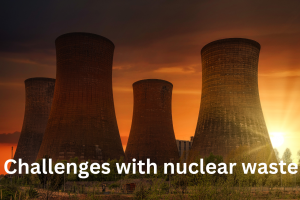ForumIAS announcing GS Foundation Program for UPSC CSE 2025-26 from 19 April. Click Here for more information.
ForumIAS Answer Writing Focus Group (AWFG) for Mains 2024 commencing from 24th June 2024. The Entrance Test for the program will be held on 28th April 2024 at 9 AM. To know more about the program visit: https://forumias.com/blog/awfg2024
Source: The post challenges with nuclear waste has been created, based on the article “How is nuclear waste generated?” published in “The Hindu” on 13th March 2024.
UPSC Syllabus Topic: GS 3 – Economy – infrastructure (nuclear energy) and Environment – Conservation, environmental pollution and degradation
Context: This article discusses how nuclear waste is created in nuclear reactors and the challenges of managing it. It explains the methods used to handle, store, and treat nuclear waste, including the reprocessing of spent fuel. Challenges with nuclear waste
What is nuclear waste?
Nuclear waste is the byproduct of nuclear reactors, like when uranium-235 splits into barium-144 and krypton-89. These leftover elements can’t undergo fission, so they become waste. This waste is very radioactive and needs careful storage to avoid environmental harm.
For more information read here
What are the challenges with nuclear waste?
Storage Duration: Nuclear waste requires isolation for millennia, far longer than modern humans have existed.
Accident Risks: For instance, an accident at the Waste Isolation Pilot Plant in the U.S. in 2014 released radioactive materials.
Environmental Impact: Concerns about contamination, like in Germany’s Asse II salt mine, where nuclear waste possibly affected water resources.
Cost: Managing nuclear waste is expensive, adding $1.6-7.1 per MWh to nuclear energy costs.
Liquid Waste Management: Challenges include how to safely treat and store liquid waste, as highlighted by issues with vitrification plants.
What are the best practices of nuclear waste management?
Cooling and Dry Cask Storage: Spent fuel is initially cooled underwater for decades, then transferred to dry casks for safer, long-term storage.
Liquid Waste Treatment: Treatment and controlled release into the environment, like Japan’s disposal of Fukushima’s treated water into the Pacific Ocean.
Geological Disposal: Burying waste underground in special containers, away from human activities, in stable geological formations like granite or clay.
Reprocessing: Separating fissile material from spent fuel for further use, reducing waste volume and increasing fuel efficiency, as practiced in India’s reprocessing plants in Trombay, Tarapur, and Kalpakkam.
How does India handle its nuclear waste?
Reprocessing Plants: India has facilities in Trombay, Tarapur, and Kalpakkam. Trombay reprocesses fuel for plutonium production, while Tarapur and Kalpakkam handle spent fuel from power reactors.
On-Site Management: Nuclear power stations in India manage low and intermediate-level waste on-site, treating and storing it in specialized facilities.
On-Site Management: Nuclear power stations in India manage low and intermediate-level waste on-site, treating and storing it in specialized facilities.
Operational Challenges: There are concerns about the efficiency of these plants. For example, the delays in the PFBR project suggested operational issues at Tarapur and Kalpakkam, with a combined capacity factor of around 15%.
Future Complications: Handling waste from the PFBR will introduce new challenges due to its unique fission product and transuranic element composition.
Question for practice:
Examine how India handles its nuclear waste, including the methods and challenges associated with its.





